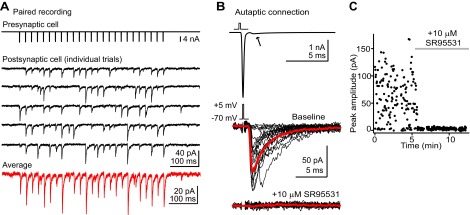Fig. 5.

Reciprocal synaptic connections and autapses in DCN stellate cells. A: example recording of a synaptically coupled pair of stellate cells. The presynaptic cell (top trace) is held in voltage clamp and escaping spikes are triggered by short voltage steps. Middle traces (black) are 5 consecutive sweeps showing time-locked IPSCs in a postsynaptic stellate cell. Bottom trace (red) is an average of multiple trials from this cell. These experiments were performed in the presence of NBQX/R-CPP to block AMPA and NMDA receptors. IPSCs are inward due to a high-Cl− internal solution. B, top: a voltage step evokes a single escaping spike in a stellate cell. The arrow points to a small but significant synaptic current observed after the action current, typical of autaptic transmission. Middle traces are example autaptic IPSCs from this stellate cell. Note the difference in scale bar from the top trace. Black traces are individual trials; red trace is an average of successful transmission events. Bottom traces are recordings after bath application of SR95531. The escaping spike artifact was removed from these traces by digitally subtracting an average of transmission failures. C: time course of the experiment shown in B.
